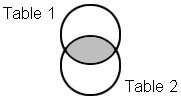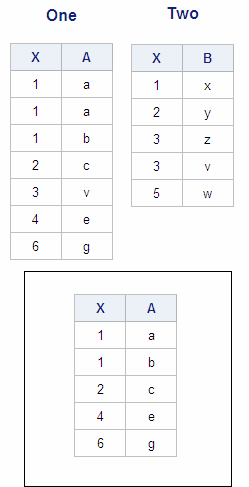Understanding Set Operations
Overview
A set operation contains
-
two queries (each beginning with a SELECT clause)
-
a set operator
-
one or both of the keywords ALL and CORR (CORRESPONDING).
|
General form of an SQL
query using a set operator:
SELECT column-1<,
... column-n>
FROM table-1
| view-1<,
... table-n | view-n>
<optional
query clauses>
set-operator <ALL> <CORR>
SELECT column-1<,
... column-n>
FROM table-1
| view-1<,
... table-n | view-n>
<optional
query clauses>;
SELECT
specifies the column(s)
that will appear in the result.
FROM
specifies the table(s)
or view(s) to be queried.
optional query clauses
are used to refine
the query further and include the clauses WHERE, GROUP BY, HAVING,
and ORDER BY.
The query or set operation
contains one semicolon, which is placed after the last SELECT statement.
|
Example
In the following PROC
SQL step, the SELECT statement contains one set operation. The set
operation uses the set operator UNION to combine the result of a query
on the table Sasuser.Stress98 with the result of a query on the table
Sasuser.Stress99.
proc sql; select * from sasuser.stress98 union select * from sasuser.stress99;
You learn the details
about using each set operator later in this chapter.
Processing a Single Set Operation
Using Multiple Set Operators
A single SELECT statement
can contain more than one set operation. Each additional set operation
includes a set operator and a group of query clauses, as shown in
the following example:
proc sql; select * from table1 set-operator select * from table2 set-operator select * from table3;
This SELECT statement
uses two set operators to link together three queries.
Regardless of the number
of set operations in a SELECT statement, the statement contains only
one semicolon, which is placed after the last query.
Processing Multiple Set Operations
When PROC SQL evaluates
a SELECT statement that contains multiple set operations, an additional
processing step (step 3 below) is required:
-
If the set operation contains more than two queries, then the result from the first two queries (enclosed in parentheses in the following examples) becomes an operand for the next set operator and operand. For example:
-
with two set operators: (Table1 UNION Table2) EXCEPT Table3
-
with three set operators: ((Table1 UNION Table2) EXCEPT Table3) INTERSECT Table4.
-
Note: When processing set operators,
PROC SQL follows a default order of precedence, unless this order
is overridden by parentheses in the expression(s). By default, INTERSECT
is evaluated first. OUTER UNION, UNION, and EXCEPT all have the same
level of precedence.
Introducing Set Operators
Each of the four set
operators EXCEPT, INTERSECT, UNION, and OUTER UNION selects rows and
handles columns in a different way, as described below.
Note: In the following chart, Table 1 is the table that is
referenced in the first query and Table 2 is the table that is referenced
in the second query.
|
Set Operator
|
Treatment of Rows
|
Treatment of Columns
|
Example
|
|---|---|---|---|
|
EXCEPT
|
Selects unique rows
from the first table that are not found in the second table.
 |
Overlays columns based
on their position in the SELECT clause without regard to the individual
column names.
|
proc sql;
select *
from table1
except
select *
from table2; |
|
INTERSECT
|
Selects unique rows
that are common to both tables.
 |
Overlays columns based
on their position in the SELECT clause without regard to the individual
column names.
|
proc sql;
select *
from table1
intersect
select *
from table2; |
|
UNION
|
Selects unique rows
from both tables.
 |
Overlays columns based
on their position in the SELECT clause without regard to the individual
column names.
|
proc sql;
select *
from table1
union
select *
from table2; |
|
OUTER
UNION
|
Selects all rows from
both tables.
The OUTER UNION operator
concatenates the results of the queries.
 |
Does not overlay columns.
|
proc sql;
select *
from table1
outer union
select *
from table2; |
Note: A set operator that selects
only unique rows displays one occurrence of a given row in output.
Processing Unique versus Duplicate Rows
When processing
a set operation that displays only unique rows (a set operation that
contains the set operator EXCEPT, INTERSECT, or UNION), PROC SQL makes
two passes through the data, by default:
For set operations that
display both unique and duplicate rows, only one pass through the
data (step 2 above) is required.
Combining and Overlaying Columns
You can use a set
operation to combine tables that have different numbers of columns
and rows or that have columns in a different order.
Three of the four set
operators (EXCEPT, INTERSECT, and UNION) combine columns by overlaying
them. (The set operator OUTER UNION does not overlay columns.)
By default, the set
operators EXCEPT, INTERSECT, and UNION overlay columns based on the
relative position of the columns in the SELECT clause. Column names
are ignored. You control how PROC SQL maps columns in one table to
columns in another table by specifying the columns in the appropriate
order in the SELECT clause. The first column specified in the first
query's SELECT clause and the first column specified in the second
query's SELECT clause are overlaid, and so on.
When columns are overlaid,
PROC SQL uses the column name from the first table (the table referenced
in the first query). If there is no column name in the first table,
the column name from the second table is used. When the SELECT clause
contains an asterisk (*) instead of a list
of column names, the set operation combines the tables (and, if applicable,
overlays columns) based on the positions of the columns in the tables.
For example, the following
set operation uses the set operator EXCEPT, so columns are overlaid.
The SELECT clause in each query uses an asterisk (*), so the columns
are overlaid based on their positions in the tables. The first column
in table One (X) is overlaid on the first column in table Two (X),
and so on.
In order to be overlaid,
columns in the same relative position in the two SELECT clauses must
have the same data type. If they do not, PROC SQL generates a warning
message in the SAS log and stops executing. For example, in the tables
shown above, if the column One.X had a different data type than column
Two.X, the SAS log would display the following error message.
ERROR: Column 1 from the first contributor of EXCEPT is not the same type as its counterpart from the second. |
Next, we use the keywords
ALL and CORR to modify the default action of the set operators.
Modifying Results By Using Keywords
To modify the behavior
of set operators, you can use either or both of the keywords ALL and
CORR immediately following the set operator:
proc sql;
select *
from table1
set-operator <all> <corr>
select *
from table2;The use of each keyword
is described below.
|
Keyword
|
Action
|
Used When...
|
|---|---|---|
|
ALL
|
Makes only one pass
through the data and does not remove duplicate rows.
|
You do not care if there
are duplicates.
Duplicates are not possible.
ALL cannot be used with
OUTER UNION.
|
|
CORR (or CORRESPONDING)
|
Compares and overlays
columns by name instead of by position:
If an alias is assigned
to a column in the SELECT clause, CORR use the alias instead of the
permanent column name.
|
Two tables have some
or all columns in common, but the columns are not in the same order.
|
In the remainder of
this chapter, you learn more about the use of each set operator, with
and without the keywords ALL and CORR.
..................Content has been hidden....................
You can't read the all page of ebook, please click here login for view all page.

